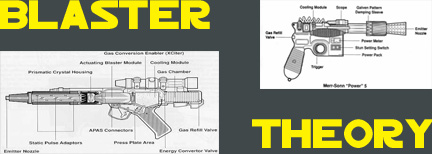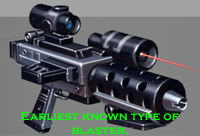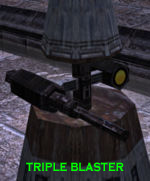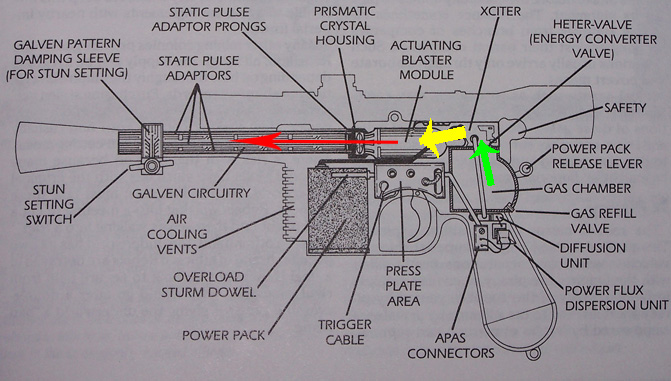Blaster Theory
Blasters
Slugthrowers
Grenades
Melee Weapons
Other Weapons
Course Exam

BLASTER THEORY AND HISTORY
Lasers were the first energy weapons in the galaxy. Producing a high-energy beam of coherent light, lasers were inefficient and required large support apparatus to inflict significant damage, limiting their combat effectiveness. Lasers were replaced by beam tubes over twenty thousands years before the Battle of Yavin. Consisting of a focusing tube connected to an ammunition and equipment backpack by a short hose, these weapons were unwieldy, and had a maximum range of 50 meters, but retained popularity for many centuries.
The oldest known blaster rifles appeared in the Rakatan Infinite Emprire cira 3956 BBY. The primitive weapons were portable, but very bulky and heavy. Ancient circuitry and energy conversion systems could only power the device for a few shots before undergoing a time-consuming reloading process.

Triple blasters were effective but immobile weapons invented during the Galactic Republic. They operated by using three separate blasters connected to a single targeting system and fired at a single target for maximum effect. The triple blasters were often fire-linked in groups of two or four for greater rate of fire and damage. These weapons were replaced by the first true blasters, which generated the deadly bolts without external apparatus. This is the same basic design which is still in service today.

OPERATION
Shown below is a schematic diagram of the popular BlasTech DL-44 Heavy Blaster Pistol:

Blaster technology relies upon two key components: blaster gas and a power pack. Every blaster contains a small quantity of volatile gas contained in the Gas Chamber. The gas is available in several varieties including eleton, orveth, prothium, sig, skevon, tibanna, and tolium, each with its own color.
- Pulling the trigger opens the Heter-Valve energy converter, releasing a small amount of gas into the Xciter Chamber.
- Inside the Xciter, the gas is bombarded with energy from the blaster's power pack, which excites the gas into a high energy state.
- This excited gas flows into the Actuating Blaster Module where it expands and cools, releasing an intense burst of energy through the Prismatic Crystal. Galven circuitry in the barrel focuses the beam into a coherent and deadly bolt.
- Additional galven damping sleeves reduce the bolt's energy if the stun setting is selected.
Blasters consume very little gas during operation. A single filled gas chamber will typically last many hundreds of shots. The primary limiting factor for blaster ammunition is the limited energy contained within the replaceable power pack. These power packs are easily recharged and are available in standard sizes made for the different classes of blaster weapons, e.g. pistol, heavy pistol, rifle, etc. Rifle and carbine power packs are not compatible with pistol or heavy pistol power packs due to size and energy requirement differences.
The intensity of a blaster bolt depends upon how much energy is consumed with each shot. The more energy drained from the power pack, the more damaging the bolt is, but the number of available shots is decreased. This is why heavy blaster pistols inflict 25-50% more damage than regular blaster pistols, but have less than half the ammunition capacity of their smaller counterparts.
Blaster rifles contain large gas reservoirs and power packs, providing increased damage and ammunition over pistols. The longer barrels of rifles and carbines contain more galven circuitry, which more efficiently focuses the bolt, allowing for longer ranges and slightly more damage.